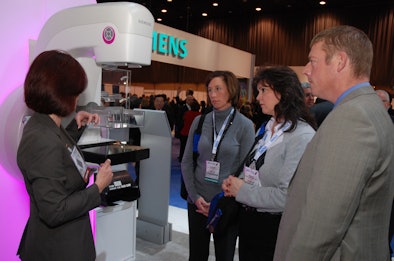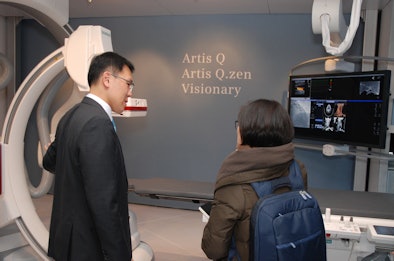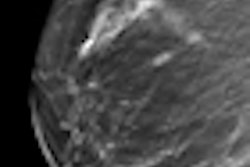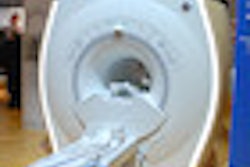
CHICAGO - A new digital mammography system with lower radiation dose, a wireless ultrasound probe, a 3-tesla MRI scanner designed for high-performance clinical and research work, and a new line of angiography systems are among the highlights in the RSNA 2012 booth of Siemens Healthcare.
Women's imaging
Mammomat Inspiration Prime Edition is a new version of the company's Inspiration full-field digital mammography system that sports recent enhancements designed to reduce radiation dose by up to 30% while maintaining image quality.
Siemens achieved the dose reduction by developing a technique based on gridless imaging. Mammography exams are typically performed with a grid to reduce scatter radiation, which can result in artifacts on images, but the grid absorbs some radiation from the primary x-ray beam, requiring higher settings to be used to penetrate the patient.
 |
| Siemens is showing its new Mammomat Inspiration Prime Edition. |
Siemens developed an image reconstruction algorithm called Prime (progressive reconstruction, intelligently minimizing exposure) that removes scatter radiation via progressive image reconstruction. The technique is intended to identify scatter-causing structures and calculates a corrected image, enabling complete use of primary radiation, according to the company.
Radiation dose can be reduced further, to a total of 50% of the dose of competing systems, through the use of a tungsten/rhodium target/filter combination. The system also includes a new second-generation digital detector, called Volex, that's based on amorphous selenium and that supports resolution down to 85 microns.
Siemens filed a 510(k) application with the U.S. Food and Drug Administration (FDA) for Inspiration Prime a week before the RSNA 2012 show, and the system is being shown as a work-in-progress.
Ultrasound
Siemens is introducing its new Acuson Freestyle ultrasound system for clinical applications that require a sterile environment, such as interventional radiology, anesthesiology, critical care, cath labs, or emergency care. Acuson Freestyle has a 38-cm high-resolution LED display and a console that can be mounted on a lightweight cart and operates on battery power.
The unique feature of Acuson Freestyle is its wireless transducers for general, vascular, and high-frequency applications such as musculoskeletal and nerve imaging.
 Siemens' Acuson X700 ultrasound system.
Siemens' Acuson X700 ultrasound system.
Six years in development, the three models of the wireless transducer feature ultrawideband technology, which operates at a high frequency of 7.8 GHz and is unaffected by nearby electronic equipment or other wireless transmissions within a healthcare facility.
Users can operate the transducers up to 3 meters away from the system, which includes an ergonomic interface for remote control of scanning parameters from within the sterile field. Wireless real-time ultrasound data transmission is enabled through the proprietary development of a novel ultrawideband radio technology.
Siemens also brought its new Acuson X700 ultrasound system to the RSNA 2012 show after initially introducing the product at last month's Medica annual meeting in Germany. Imaging technologies that were previously available only on the company's premium ultrasound systems are now standard features on Acuson X700.
The scanner also offers a new single-solution, 50-mm aperture linear-array transducer for both superficial and deep imaging.
In addition, Siemens is showing its compact Acuson P300 ultrasound system, designed for a variety of clinical settings ranging from general radiology to cardiovascular and from obstetrics and gynecology to specialty imaging, including breasts and small parts.
Acuson P300 also has advanced image optimization technologies, such as speckle reduction and spatial compounding, and comes with 13 multifrequency transducers with a frequency range of up to 18 MHz.
MRI
Magnetom Prisma is a new 3-tesla MRI scanner that's targeted at demanding clinical and research applications, with more powerful gradients.
Prisma features gradients rated at 80 mT/m, with a slew rate of 200 T/m/sec. The system also has a diffusion spectrum imaging (DSI) protocol for visualizing fine anatomical detail.
In other Siemens MRI news, the company has been moving its Dot (day optimizing throughput) workflow improvement protocols to other scanners in the MRI product line. Dot will be available on the Magnetom Essenza 1.5-tesla scanner, enabling technologists to set up scans that are more automated and improve throughput. Essenza with Dot is pending FDA clearance.
Meanwhile, the Magnetom Trio, Verio, and Avanto scanners are getting upgrades to Dot, as well as to Tim 4G (total image matrix), the company's integrated coil and radiofrequency technology. The technologies are also being offered to the company's installed base.
Siemens is also bringing the latest version of its MR software platform -- syngo MR D13 -- to the Magnetom Aera 1.5-tesla and Magnetom Skyra 3-tesla scanners. The software platform offers new capabilities for image acquisition as well as new Dot engines for breast, spine, and large-joint examinations.
For example, syngo Warp supports the imaging of patients with MR-conditional metal implants, while syngo Resolve is a technique for high-resolution diffusion-weighted imaging. Also new is syngo Caipirihina, which has the potential to cut in half the time needed for liver examinations. Siemens is also making syngo MR D13 available for the Avanto and Verio systems.
CT
Somatom Perspective 64 is a budget-oriented 64-slice version of the Perspective 128 CT scanner that Siemens introduced in 2011. The new system includes all the dose-reduction protocols found on the higher-end model.
 Siemens' Somatom Perspective scanner.
Siemens' Somatom Perspective scanner.
The scanner will also feature an e-mode technique, designed to reduce scanner wear and tear. If Siemens customers use e-mode in at least 80% of exams, they can receive discounts on service contracts.
On the instrumentation side, Siemens is now offering its Stellar detector to the installed base of single-source Somatom Edge and dual-source Somatom Flash users. The scanners are field-upgradable and make Stellar's low-noise capabilities -- which integrate the detector's miniaturized electronics within the photodiode -- available to additional Siemens CT owners.
Siemens is also discussing a new approach to the debate over radiation dose in CT exams. While much of the push by vendors lately has been on achieving submillisievert CT scans, this drive ignores the fact that imaging at such low doses might not be appropriate for many clinical applications, which simply require more radiation.
Instead, Siemens believes that absolute values should be developed that detail the appropriate doses for different clinical exams, an approach that would make it easier to compare dose levels between different scanners.
X-ray
Cios Alpha is a new C-arm that is being shown as a work-in-progress, as it does not yet have U.S. FDA clearance. The system has a field-of-view that's up to 25% larger to give surgeons a bigger viewing area thanks to new radiographic collimators, and it's designed to provide high-quality vascular images even at an output of more than 25 kV.
Other features include a better user interface, a motorized arm with a position storage function, and a touchscreen display.
Mobilett Mira is a mobile digital radiography (DR) system that has both a wireless and a wired detector that transmits image data via W-LAN, which Siemens believes facilitates examinations of critically ill patients with limited mobility. The system has a resolution exceeding 7 million pixels, short exposure times beyond 1 msec, and a swivel arm that not only moves vertically but also rotates up to 90º.
The company is also showing Luminos Agile, a DR/fluoroscopy unit with a 17 x 17-inch digital detector, which Siemens believes produces images that are 116% larger than a 13-inch image intensifier, enabling better patient coverage.
Interventional imaging
Siemens made a splash at this year's RSNA show by launching its new line of Artis Q angiography systems.
The new systems will come in two configurations: Artis Q and Artis Q.zen, with the latter system becoming the premium offering in the vendor's angiography portfolio. Both systems will carry new Siemens Gigalix flat-emitter x-ray tube technology designed to reduce dose, while Artis Q.zen will sport both redesigned digital detectors as well as new visualization techniques for procedures such as stent placement.
The new detectors are based on crystalline silicon rather than the amorphous silicon previously used in Siemens angiography systems. The crystalline structure is more homogenous and thus allows for more effective amplification of signals.
That translates into lower radiation dose: In field tests at sites in Europe, Artis Q.zen is producing fluoroscopy doses that are sometimes half of what might be found with a conventional amorphous silicon detector, according to the company.
 |
| Siemens' Artis Q.zen, part of its new line of angiography systems. |
Another new technology is syngo ClearStent Live, which recognizes and tracks stents in dynamic cardiac images, correcting for motion and using an overlay to create a significantly enhanced image of the stent. The technique compensates for motion so interventional physicians have the impression of a perfectly motionless stent; they can then thread a guidewire through the stent more easily. The application is particularly useful for placing stents one after another.
Other new applications include syngo DynaCT Micro, an enhanced version of Siemens' DynaCT tool for performing CT-like imaging on an angiography system, and syngo DynaPBV Body, which takes the company's parenchymal blood volume (PBV) technology for brain imaging and adapts it for body work, producing color-coded, cross-sectional maps, such as for visualizing tumors.
Siemens plans to start shipping the Artis Q systems in Europe sometime in 2013, and a 510(k) application is pending with the FDA. Two Artis Q.zen systems are installed in Europe.
Molecular imaging
Siemens has introduced its new syngo.PET Amyloid Plaque molecular imaging software to visualize and quantify amyloid plaque in a living brain, which has been associated with the onset of Alzheimer's disease.
Siemens is pairing the syngo.PET Amyloid Plaque software with its Biograph mCT PET/CT scanner and PETNet Solutions' production and distribution of Eli Lilly's Amyvid (florbetapir F-18 injection) PET agent for Alzheimer's disease.
Syngo.PET Amyloid Plaque has received FDA clearance and is intended for use only with approved amyloid radiopharmaceuticals in the country of use.
Siemens is also showcasing its new iPad application for Symbia.net, which allows access to full processing and reading capabilities from any location. The Symbia.net iPad app is intended for nondiagnostic imaging only.
PACS and advanced visualization
Siemens is unveiling new enhancements to its syngo.via software for 3D routine and advanced viewing. The software now includes new applications for mammography reading and for complex examinations in neurology, oncology, and cardiovascular diagnostics, according to the company.
A new feature called region growing enables users to better visualize anatomical structures from volume datasets, for example, from vascular or neurological examinations. This improved view assists both diagnosis and surgical planning.
Siemens is also launching syngo.via Element, an entry-level product for 3D routine and advanced image reading for lower-volume facilities just moving to midrange multislice CT scanners. The software configuration is based on the latest syngo.via version and includes applications and functionalities specifically designed for reading CT studies, such as in neurology and oncology. It is available with the company's Somatom Emotion and Somatom Perspective scanners.
Finally, Siemens is demonstrating a new version of its syngo.plaza PACS and reading software. The new VA20D version includes a navigation feature called token view that helps readers remain oriented while going through large numbers of images.
Radiation oncology
In radiation therapy, Siemens is discussing the rollout to North America of its partnership with Varian Medical Systems, which was established in international markets earlier in 2012.
Under the deal, Varian represents Siemens medical imaging products such as CT, PET/CT, and MRI to radiation oncology clinics in North America and in most international markets, while Siemens represents Varian equipment and software for radiotherapy and radiosurgery to its customers.



















